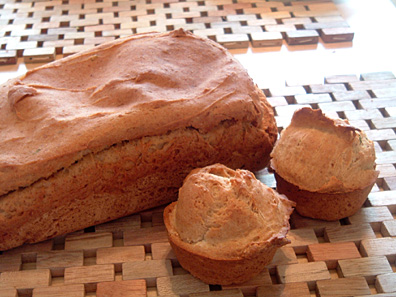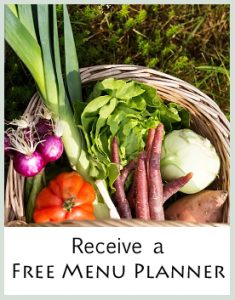
Rosemary Potato Bread, photo by Sarah Schatz
For years I avoided delving into the process of creating gluten-free baked goods because it simply seemed too daunting to me. At the time, I didn’t know of any good gluten-free baking books and part of me believed that gluten-free really wasn’t going to taste that great, so why try? I got by with gluten-free frozen breads but I always felt like I was eating to to fill my stomach, instead of actually enjoying what I was eating.
This usually led me down the path of “eating wheat or spelt in moderation” which always came back to kick me in the bud. I have now learned that for me, I have to stick to my gluten-free diet completely, otherwise I slowly start to go overboard with my consumption of glutenous products.
But one thing that truly helped me with this transition was the discovery of “good” gluten-free baking. It truly opened my eyes (and taste buds) to what gluten-free baked goods can taste like with the right combination of gluten-free ingredients.
And to be quite honest with you, once I got over the “withdrawal hump,” I actually didn’t crave them as much. This may happen to you, too. I also don’t miss regular bread because the gluten-free alternatives can be so good.
I will add one more note here about gluten-free baking. It takes patience. Patience with yourself to keep trying, even after you bake something that doesn’t turn out well. To me, learning to bake gluten-free was like performing experiments where I often felt like I was chemistry class!
If you are new to this as I once was, it can be overwhelming to look at a list of gluten-free ingredients and know where to even start. It can seem overwhelming to even think about where to buy them, how much it is going to cost and what to do with them once you have them! If this is you, I am writing this post for you.
Now that I have gone through this process, it is a lot easier for me to know where I would start if I knew what I know now. Unfortunately, this is a little like going back in time and simply impossible for me. The good news is I can pass it on to you.
If you are on a budget, or if you just want to start out small and basic with this new gluten-free thing, I recommend the following basic ingredients.
- brown or white rice flour (keep brown rice flour in fridge)
- tapioca flour
- potato starch
- arrowroot powder or cornstarch (I prefer arrowroot)
- one of the following: quinoa, amaranth, millet, teff, buckwheat, montina, or sorghum (Each one of these has a slightly different taste but they work very similar to each other in baking. Experiment and find out what you like the best.)
Gluten-free baking usually takes a mixture of flours and other ingredients in order to mimic regular bread. Even then, it is still not identical. But you might be surprised at how yummy it is anyway.
Here are some gluten-free flour blends you can use in your baked goods:
Alison’s Gluten-Free (GF) Baking Mix (From Delicious Living Magazine)
- 2 parts brown rice flour
- 2 parts tapioca flour
- 1 part potato starch (not potato flour)
- 1 part arrowroot powder Steps: Combine all ingredients. When converting your own recipes, use a blend of half GF Baking Mix and half whole-grain GF flour (quinoa, amaranth, millet, teff, buckwheat, montina, or sorghum).
Bette Hagman’s Featherlight Mix( from The Gluten-Free Gourmet Cooks Comfort Foods, by Bette Hagman). I am including this mix because she uses it very often in both her quick and yeasted breads:
- 1 part rice flour
- 1 part tapioca flour
- 1 part cornstarch or arrowroot powder
- Potato flour (1 tsp per cup) (not to be confused with potato starch)
Bette uses this blend when making muffins, pancakes and waffles, biscuits, yeasted breads, quick breads and more. Sometimes it is used by itself, but mostly it is combined with other whole-grain GF flours. The proportions of GF mix to whole-grain flours are usually the same as for Alison’s GF mix but may vary a little bit.
If you are looking for just one flour to start baking with, you may want to try coconut flour or blanched almond flour. I have personally not tried these but know they work well when baking quick breads or cakes.
You will also need either xanthan gum or guar gum. These are the replacements for the gluten that is needed to hold the bread together. Without them, things tend to fall apart. Use ½ tsp xanthan gum or guar gum to every cup of flour. (Xanthan gum is pretty expensive but it goes a long way.) Note: Buckwheat flour does not need xanthan or guar gum.)
Also, dough enhancers, almond meal, and egg replacer can all helpful if you are baking quick or yeasted breads.
As far as adjusting baking ingredients you already have, you will need to use 2 level tsp of baking powder to every cup of flour.
Another ingredient that is helpful is eggs and egg whites. A blender is helpful because many recipes ask you to beat the eggs white until they are stiff. Although you can do this by hand with a whisk, it takes much longer and it is a bit tiring.
Another reason to use a blender is that the dough of a yeasted gluten-free bread is not like your normal wheat dough. It is sticky and looks like thick cake batter. Although I have used my hands to knead my GF pizza dough, I usually stick to the blender when kneading the GF yeasted breads.
Another ingredient that some recipes may call for that you can buy at most grocery stores is gelatin. I use Knox unflavored gelatin. Bette Hagman uses it in almost every yeasted bread recipe. It is most likely to add “bounce” to the bread, which her breads do have. If you don’t want to use gelatin for any reason, try using agar agar instead. It is a seaweed and will be found in the asian or baking section of the store. Or, you can experiment with leaving this ingredient out.
All breads, either yeasted or quick, need some kind of sweetener. Most bread recipes call for sugar, but I personally enjoy using honey, agave nectar, or maple syrup to replace the sugar. If your batter seems too soupy, add a little bit more flour mix until you get the right consistency.
These tips are just the starters. If you are looking for more gluten-free baking tips, this GF bread blog post by the Gluten Free Girl may help you.
And finally, the recipe!
Potato Rosemary Bread (based on Bette Hagman’s Potato Bread)
Dry Ingredients:
3 cups Bette’s Potato Flour Mix (1 1/4 parts rice flour, 1 part tapioca flour, 1 part potato starch)
1 cup sorghum flour (you could try another whole-grain GF flour)
3 tsp. xanthan gum
2 tsp. Egg Replacer (adds leavening to bread)
2 tsp. gelatin
1/3 cup almond meal or buttermilk powder
1 tsp salt
1 1/2 Tbsp. fresh rosemary, chopped fine
Wet Ingredients:
2 cups warm water (more or less)
1 tsp agave nectar or maple syrup (for yeast mixture)
1 Tbsp. yeast
1 egg plus 3 egg whites
1 tsp dough enhancer
6 Tbsp. vegetable oil
additional 1 1/2 Tbsp. maple syrup (for dough)
Steps:
- Grease two 8 1/2″ x 4 1/2″ loaf pans and dust with rice flour. (Or one loaf pan and 8 or 9 muffin tins to make rolls)
- In a glass measure, stir the water with yeast and sweetener. Set aside to proof until the foam is approximately 1/2″.
- In a medium bowl, combine the dry ingredients.
- In the bowl of your mixer, gently beat the eggs, dough enhancer and vegetable oil. Add most of the yeast-water. With the mixer on low, slowly add the dry ingredients. Add the remaining yeast-water until the batter becomes like thick cake batter. Turn your mixer on high and beat for 3 1/2 min.
- Spoon the dough into the prepared pans, cover and let rise for 35-40 minutes for rapid rise yeast, or 60 minutes or more for regular yeast. Bake in the pans at 400 F for 10 min. Then cover with aluminum foil and bake the loaf for an additional 50 minutes and the muffins for another 10-15 minutes at 375 F.
- The bread and rolls should come out very easily after baked if your dusted the pans with flour.
- Enjoy with butter, coconut oil, spreads, nut butters, or just plain.

I tried this out thinking it would be great! I was very disappointed! It tasted very dry and almost tasteless from the beginning and got worse. Also, it is my first gluten free bread I’ve made that molded after a few days!
Hi Kangachick,
I’m very sorry to take this long to get back to you about your comment. I moved and the past month or so has been very upside down and busy.
I’m very sorry to hear that the bread didn’t turn out. My experience of the recipe is very different – I find it very moist and lighter than most gluten-free breads. I’ve also never had it mold on me before. Did you change the recipe at all?
Sorry to hear it didn’t work out,
Sarah
Any idea what I could use for egg replacer? I don’t have any on hand and would hate to buy a whole box for just 1 recipe. I don’t have any dietary restrictions other than gluten, dairy and soy. Thanks.
Hi Magda,
It kind of depends on what you’re baking but I find that flax seed meal works very well as an egg replacer. Use 1 Tbsp flax meal to 3 Tbsp boiling water per egg. Let sit for 10 minutes or so and then add to the rest of the ingredients. If a recipe has more than 2-3 eggs in it, it may be hard to come up with a good egg-free version of the recipe.
Applesauce, pear sauce, banana puree, cooked squash puree and prune puree can also be used as egg replacers but these do add a little sweetness and flavor to the bread.
Good luck!
Sarah
Hi Sarah
thanks for a great article
my doctor put me on a gluten-dairy-corn-potato-free diet and it was the end of my life as i knew it! then i discovered the GF online world 🙂 i still didn’t try baking anything yet but i have been browsing and kind of gathering information. Your article just made everything clear!!!!
Thank you so much for passing on the wisdom.
Lama